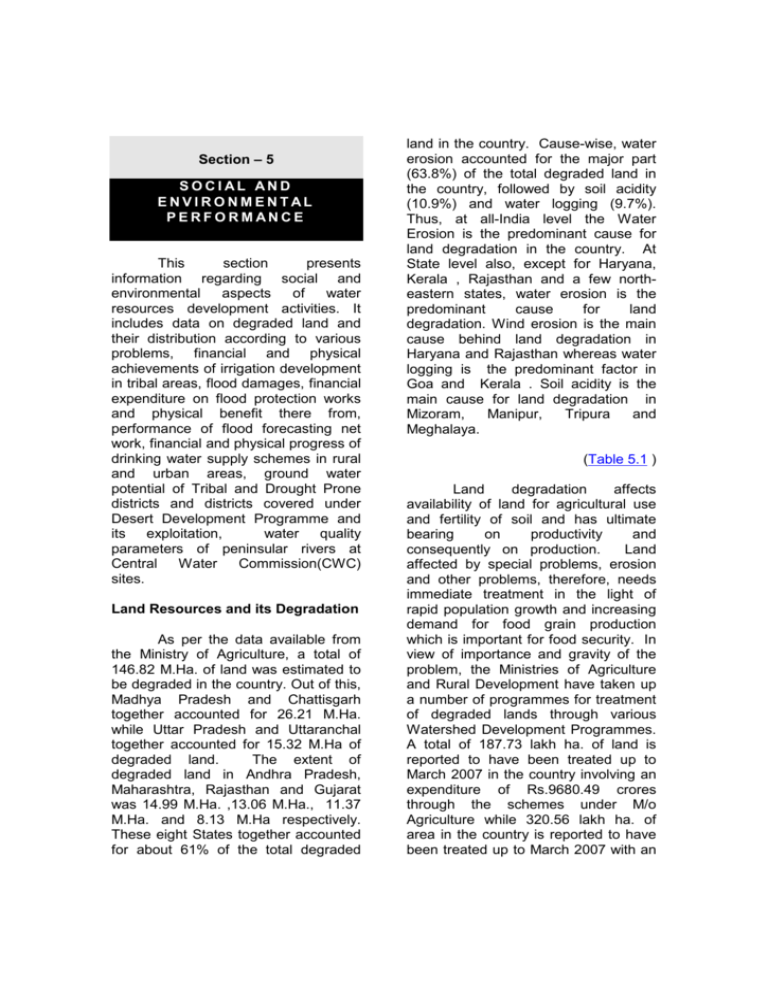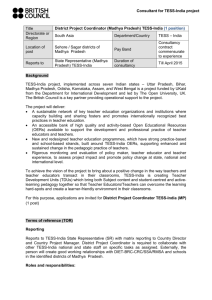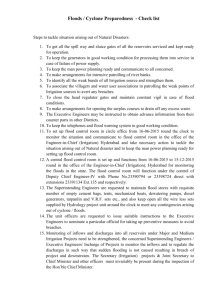social and environmental performance
advertisement

Section – 5 SOCIAL AND ENVIRONMENTAL PERFORMANCE This section presents information regarding social and environmental aspects of water resources development activities. It includes data on degraded land and their distribution according to various problems, financial and physical achievements of irrigation development in tribal areas, flood damages, financial expenditure on flood protection works and physical benefit there from, performance of flood forecasting net work, financial and physical progress of drinking water supply schemes in rural and urban areas, ground water potential of Tribal and Drought Prone districts and districts covered under Desert Development Programme and its exploitation, water quality parameters of peninsular rivers at Central Water Commission(CWC) sites. Land Resources and its Degradation As per the data available from the Ministry of Agriculture, a total of 146.82 M.Ha. of land was estimated to be degraded in the country. Out of this, Madhya Pradesh and Chattisgarh together accounted for 26.21 M.Ha. while Uttar Pradesh and Uttaranchal together accounted for 15.32 M.Ha of degraded land. The extent of degraded land in Andhra Pradesh, Maharashtra, Rajasthan and Gujarat was 14.99 M.Ha. ,13.06 M.Ha., 11.37 M.Ha. and 8.13 M.Ha respectively. These eight States together accounted for about 61% of the total degraded land in the country. Cause-wise, water erosion accounted for the major part (63.8%) of the total degraded land in the country, followed by soil acidity (10.9%) and water logging (9.7%). Thus, at all-India level the Water Erosion is the predominant cause for land degradation in the country. At State level also, except for Haryana, Kerala , Rajasthan and a few northeastern states, water erosion is the predominant cause for land degradation. Wind erosion is the main cause behind land degradation in Haryana and Rajasthan whereas water logging is the predominant factor in Goa and Kerala . Soil acidity is the main cause for land degradation in Mizoram, Manipur, Tripura and Meghalaya. (Table 5.1 ) Land degradation affects availability of land for agricultural use and fertility of soil and has ultimate bearing on productivity and consequently on production. Land affected by special problems, erosion and other problems, therefore, needs immediate treatment in the light of rapid population growth and increasing demand for food grain production which is important for food security. In view of importance and gravity of the problem, the Ministries of Agriculture and Rural Development have taken up a number of programmes for treatment of degraded lands through various Watershed Development Programmes. A total of 187.73 lakh ha. of land is reported to have been treated up to March 2007 in the country involving an expenditure of Rs.9680.49 crores through the schemes under M/o Agriculture while 320.56 lakh ha. of area in the country is reported to have been treated up to March 2007 with an investment of Rs 9523.20Crore through the schemes under Ministry of Rural Development. (Table 5.2) Drought Prone Area Programme As per the data available from the Ministry of Rural Development the list of districts covered under Drought Prone Area Programme along with the no of blocks and their area is presented statewise. It is observed that the maximum drought prone area falls under the state of Maharashtra followed by Andhra Pradesh and Madhya Pradesh. (Table 5.3) Irrigation Development Under Tribal Sub-Plan The Tribal Sub-Plan (TSP) came into operation during V Plan. As per the latest available data, a total of 684 (161 major, 481 medium and 42 ERM) irrigation projects are lying under TSP. New projects of X Plan are confined to the States of Andhra Pradesh, Assam, Jharkhand, Gujarat, Madhya Pradesh, Orissa, West Bengal and Chattisgarh. The total ultimate potential from these 684 TSP projects since inception is 17.5 M.ha., out of which 1.89 M.ha. is in Tribal areas. A total of 155 irrigation projects benefiting TSP area were completed before the start of Tribal Sub-Plan. The ultimate irrigation potential of these projects was about 2392 Thousand Hectares(Th.ha.) of which only 29 Th.ha. was under the Tribal areas. A total of 49 projects were completed during IXth Plan. The ultimate potential from these projects is 1594 Th. ha. of which about 290 Th.ha. was under the Tribal areas. There are 230 ongoing projects under TSP having ultimate irrigation potential of 10.16 M.. ha. out of which 1.19 M.ha. is under Tribal area. During Xth Plan there were 51 new projects with an outlay of Rs. 1367 crore for 2002-07.These new projects having Ultimate Irrigation Potential of 981 Th Ha. are spread over 8 states namely Andhra Pradesh, Assam, Chattisgarh, Jharkhand, Gujarat, Madhya Pradesh, Orissa and West Bengal. Among the States, Maharashtra has the maximum number of on-going projects (68) under Major, Medium and ERM irrigation projects benefiting TSP followed by Gujarat (27) and Jharkhand (22). The ultimate potential is highest for the State of Gujarat followed by Maharashtra and Andhra Pradesh. It is lowest in case of Manipur. Amongst the available figures, the Irrigation potential in TSP area is highest in Orissa. The estimated cost of on-going projects is maximum for the State of Gujarat followed by Maharashtra and Madhya Pradesh. (Tables 5.4 to 5.10) Flood Flood is one of the most devastating natural calamities, which has been causing extensive damage to life and property besides perpetrating tremendous sufferings. Since flood is a natural phenomenon, it is usually difficult to predict a definite trend especially with regard to the time and place of its occurrence. As such, the effort usually is to take appropriate advance flood protection measures. The area affected by floods was 2.29 m.ha. in 1953 and 3.38 m.ha. in 2005 with a peak of 17.5 m.ha. during 1978. At current prices, the damage to crops was in the wide range of Rs. 5.87 crore in 1965 and Rs. 4246.2 crore in 2000. The floods also caused extensive damage to crops worth Rs 958 crore in 2005. In addition, there was a great loss of human lives and livestock often affecting the poor strata of the population. Taking into consideration the other factors such as serious disruption and massive health rehabilitation measures needed, the loss could indeed be tremendous. The total damage caused by floods is estimated to the tune of Rs.2822 crore during 2005. Karnataka and Kerala are worst effected in terms of the total damage to crops, houses and public utilities, as per the information available for the States for 2007 (upto 31.10.07). There has been a considerable increase in the governmental expenditure on flood management programme over the past years. It has gone up from Rs.13 crore during Ist Plan to Rs.5966 crore during X Plan and the approved outlay for XI plan is Rs. 10188 crore. The central assistance in flood control work has risen sharply from Rs. 462.5 crore in the IX plan to Rs. 1403 crore in the X Plan. Among the states the maximum anticipated expenditure for flood management during X Plan is for Uttar Pradesh followed by West Bengal and Bihar. As far as the area benefited upto 2006 due to flood management programme is concerned Punjab, ranks first followed by Bihar and West Bengal. (Table 5.11 to 5.17 and Chart 33) Flood forecasting is one of the most important non-structural methods of flood control in which there has been significant contribution by CWC. Network performance for the period 15/05/2005 to 31/10/2005 (5423 accurate forecasts out of 5618 issued) has been quite satisfactory. 96.6 % of forecasts were correct within +/-15 cms or +/- 20% cumecs. Over the years, the percentage of forecasts accuracy has been maintained at around 96% and above apparently due to improvement in methodology and acquisition of latest technology. (Tables 5.18 to 5.20) Water Requirement The requirement of fresh water both for irrigation and other uses is growing continuously. The requirement of water for various sectors has been assessed by the National Comission on Integrated Water Resources Development(NCIWRD) in the year 2000.This requirement is based on the assumption that irrigation efficiency will increase to 60 % from the present level of 35 -40 %. The Standing Committee of MOWR also assesses it periodically. The total water demand for all the uses is likely to be 1180 BCM by 2050 as per NCIWRD. Though major share of this would be consumed for irrigation purposes, this in no way undermines importance of providing potable drinking water. In fact, it may be presumed that drinking water provision would have to be given an added thrust since the lack of such facility is likely to entail serious social, economic and health impact. (Tables 5.21) Different schemes and programmes are being implemented with the objective of providing access to safe drinking water in rural areas whole country. Table 5.24 shows the status of coverage of rural habitations under the Rural Water Supply scheme as on April 2007. Accelerated Expenditure Rural Water under Supply Programme for supply of drinking water to rural areas during X Plan was Rs.12110 crore out of which the maximum expenditure was by Rajasthan (Rs.1655 crore). The next highest was Maharashtra where the expenditure incurred was to the tune of Rs.1180 crore. Rajasthan alongwith Maharashtra accounted for about 23% of total expenditure incurred by the country under this programme. Breakup of yearwise expenditure during the Xth Plan is also provided in the Table. (Table 5.23 & 5.24) Under Urban Water Supply Programme, 92 % of the urban population of the country was covered upto March, 2004.However, entire urban populaion of Delhi, Himachal Pradesh, Madhya Pradesh, Rajasthan, Uttaranchal and UT of Chandigarh have been covered under this programme whereas Gujarat, Jammu & Kashmir, Maharashtra, Meghalaya, Tamil Nadu,Tripura, Uttar Pradesh, and UTs of Andaman & Nicobar and Pondicherry have more than 90 % of their urban population covered under this scheme till March 2004. (Table 5.25) Water Quality Parameters The publication gives range of Variation of various water quality parameters at CWC sites for the river basins of Godavari, Cauvery, Narmada, Krishna, Mahanadi, East Flowing Rivers and West Flowing Rivers. The parameters covered include pH value, specific conductance, sodium absorption ratio, total dissolved solid and maximum values of chloride, sulphate, nitrate, iron, magnesium, sodium percentage, residual sodium carbonate and total hardness. (Tables 5.26 to 5.33)









